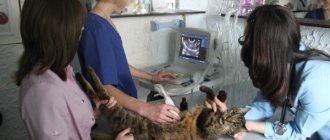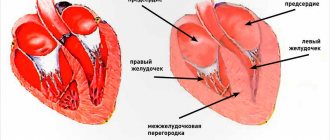Liver amyloidosis in cats - etiology and pathogenesis
It is currently believed that this is an independent, genetically determined disease that can manifest itself with varying degrees of severity or not manifest itself at all. Liver amyloidosis in cats is often provoked by lupus, chronic coccidioidomycosis and blastomycosis, bacterial inflammatory heart disease, cancer, and long-term steroid therapy.
With amyloidosis, amyloid, fibers of a waxy substance of a protein nature, is deposited in the liver. The degeneration of liver cells caused by it, disruption of its structure and nutrition leads to increased levels of liver enzymes, coagulopathy, liver failure, and intoxication with damage to other organs. Rapidly deposited amyloid can rupture the liver, resulting in massive hemorrhage into the abdominal cavity. The body's struggle with liver dysfunction leads to overload of the spleen and especially the kidneys, which results in a wide range of pathologies of the urinary system and blood circulation. The development of hepatic cysts and hyperthyroidism is possible.
Among domestic animals, liver amyloidosis is the most common in cats. The disease is more common in cats than in cats. It is more acute in young and old than in mature animals.
What causes amyloidosis in cats?
Typically, amyloid comes from a protein that is formed in response to inflammation. Any condition that causes severe inflammation can trigger the deposition of abnormal proteins, including the following:
- Chronic inflammatory disease;
- Chronic infection;
- Cancer.
This spontaneous development of amyloidosis is a relatively uncommon disorder in cats in general; however, it occurs as a genetic disorder in Abyssinian, Siamese and Oriental Shorthair breeds, according to statistics.
Liver amyloidosis in cats - symptoms
Amyloidosis can develop quickly, or proceeds slowly, without pronounced clinical manifestations, being successfully compensated by the body for a long time. In the second case, the disease may remain undetected, especially if the death of the animal was not considered untimely or was attributed to concomitant diseases.
Acute liver amyloidosis in cats is manifested by loss of appetite, vomiting, constant thirst, dark urine, hemoglobinuria, frequent urination, and dehydration. The mucous membranes of the mouth acquire a pale icteric tint, and the whites of the eyes turn yellow. Swelling of the joints is possible, sometimes turning into purulent aseptic inflammation.
The animal is severely depressed, even to the point of lethargy. The joints become painful, and sometimes non-localized, wandering pain occurs. Unlike dogs, amyloidosis rarely causes signs of meningitis in cats. When palpating the abdomen, there is a significant enlargement and thickening of the liver, fluid in the abdominal cavity (ascites or hemorrhagic effusion).
With severe symptoms, the prognosis is unfavorable: treatment can prolong the cat’s life for up to 2 years. The immediate cause of death, as a rule, is either acute renal failure or massive blood loss due to liver rupture followed by classic shock.
Diagnosis of amyloidosis in cats
Your veterinarian will first diagnose your cat with a specific tissue disease or disorder and then will need to determine that the problem is the result of amyloidosis, which can be quite severe.
According to the veterinary community, affected Siamese and Oriental Shorthair cats that deposit amyloid in their liver are sometimes present with acute internal abdominal bleeding due to rupture of the lesions. Abyssinian cats with this disease may be present at a very young age (usually 1 to 5 years of age) with rapidly progressing renal failure. Other cats that are only mildly affected can live a long life without noticeable symptoms associated with the disease.
The only way to definitively diagnose the presence of amyloidosis is to obtain biopsy samples of the affected tissue for microscopic examination with special stains.
Diagnosis of the disease
In the early, compensated stages of the disease, diagnosis is rare and extremely difficult. In addition, the signs of amyloidosis mirror those of many other diseases. A blood test can reveal anemia, increased levels of bilirubin and liver enzymes, proteinuria, and traces of bile acids. With further development, x-rays may show an enlarged liver and fluid in the abdominal cavity. Ultrasound - additionally hypoechogenicity of the liver parenchyma, thickening of the intestinal wall if it is captured by the process of amyloid deposition (rare). The most accurate diagnosis is provided by a liver biopsy and analysis of fluid from the abdominal cavity.
Description of the disease
Amyloidosis is a disorder of protein metabolism in the body of an animal, which constitutes a whole group of diseases found in cats of various breeds and ages.
It is characterized by the fact that amyloid deposits, namely protein, settle on the animal’s organs and subsequently this causes serious disruptions in their functioning. The causes of amyloidosis in cats can be any disease that reduces immunity:
- arthritis;
- peptic ulcer;
- malignant neoplasms;
- pneumonia;
- mastitis;
- endocarditis and others.
Kidney pathology
In most cats, deposits accumulate in the kidneys, which leads to chronic diseases. Most often, renal failure develops against the background of deposits.
In this case, the affected organ, instead of urine, releases valuable substances into the external environment: globulins, blood and protein. Subsequently, other diseases may develop, for example, thrombosis of veins and arteries, dropsy of the abdominal cavity.
Liver pathology
Protein deposits on the liver lead to liver failure, which develops very quickly.
In very advanced stages of the disease, there are cases of liver rupture, which is accompanied by fatal bleeding. In this case, blood transfusion and, in very severe cases, excision of the damaged part of the organ are indicated.
Are there others?
In addition to the liver and kidneys, amyloid deposits can settle on the intestines, pancreas and spleen, which causes terrible, irreversible consequences for the animal’s body.
Treatment of liver amyloidosis in cats
Like any genetically determined disease, liver amyloidosis in cats has no specific prevention and cannot be cured.
When determining the causes that provoked an exacerbation of amyloidosis, treatment is aimed at eliminating them. In the early stages of the disease, its development can be stopped by daily administration of colchicine solutions (which has severe side effects). Daily injections of dimethyl sulfoxide solution have some anti-inflammatory effect and cause the dissolution of amyloid, but are also not harmless. Perfusion of rehydration solutions provides a symptomatic effect. In case of liver rupture with minor blood loss, a blood transfusion is indicated; in case of more severe bleeding, excision of the damaged lobe of the liver is indicated.
Sick animals are prescribed a diet with a reduced content of phosphorus, sodium, and proteins. The specific composition is determined by the veterinarian, depending on the severity of the symptoms and the predominant damage to other organs.
If amyloidosis is detected in a cat, the entire genetic line to which it belongs should be removed from breeding work.
Treatment of primary renal amyloidosis
There are no medications that address the cause of primary renal amyloidosis. Treatment is aimed at reducing the symptoms of the disease, preventing the development of complications and maintaining the patient’s normal quality of life. Chemotherapy and steroid drugs are prescribed, and autologous stem cell transplantation is performed. If a patient develops end-stage renal failure, dialysis or a kidney transplant is performed.
Features and advantages of treatment of primary renal amyloidosis at the Rassvet Clinic
The Rassvet Clinic is equipped with modern diagnostic and therapeutic equipment, allowing our doctors to accurately diagnose and effectively treat kidney diseases, including rare syndromes and diseases.
Our nephrologists are highly qualified doctors, well trained, and have extensive practical experience. Conduct diagnosis and treatment of rare diseases and syndromes in accordance with international clinical guidelines.
Patients with suspected primary renal amyloidosis undergo all the necessary diagnostic tests, and individual schemes of symptomatic and supportive therapy are selected to maximize the prognosis of the rare renal pathology.
Signs that your cat has amyloidosis
Remember that amyloid deposits can occur anywhere in the body - sometimes locally, in just one place, and sometimes more systemically. In small quantities, no damage occurs and no disease is evident. Only when deposits interfere with normal organ function do clinical symptoms appear, and then they are associated with failure of the specific organ system affected:
- Liver diseases with liver amyloidosis;
- Kidney disease with renal amyloidosis.
Kidney diseases in cats and kittens
In the acute form of liver amyloidosis in cats, it is manifested by a sharp decrease in appetite, severe thirst, nausea and vomiting, frequent urination, and general dehydration of the body.
Urine is dark in color and contains proteins and blood cells. The mucous membranes of the mouth and gums become pale and acquire a jaundiced tint, and the sclera of the eyeballs also turn yellow. Joint problems, swelling, and soreness may occur. The liver increases in size, becomes dense, and fluid begins to accumulate in the abdominal cavity. The prognosis for the acute form of the pathology is not very favorable. Maintenance medications can briefly prolong an animal's life. Death occurs as a result of acute failure of kidney function due to severe poisoning of the body with cell breakdown products, or from severe blood loss due to rupture of liver tissue and shock.
- Change in urination pattern: increase or decrease in frequency.
- Change in urine color: blood or cloudiness.
- Pain when urinating (the pet demonstrates this through its behavior).
- Temperature increase.
- Lethargy, apathy, loss of appetite.
With renal amyloidosis in cats, one or more symptoms are observed. If you notice any suspicious signs, do not delay – make an appointment with a doctor immediately.
The kidneys are a paired organ (there are two of them in the body), which performs many different functions: hormonal, maintaining the acid level and electrolyte composition of the blood, regulating blood pressure. But the main task of the kidneys is to filter metabolic products. The kidneys constantly cleanse the body of toxins and maintain the required amount of water in the body. Detoxification is carried out by the formation and excretion of urine with harmful substances dissolved in it.
The bud has the shape of a bean. On the outside it is covered with a dense capsule; inside there is a layer of kidney tissue itself. Without going into anatomical details, the kidney can be conditionally divided into two functional parts: the renal tissue itself is responsible for filtering the blood with the formation of urine, and the pyelocaliceal system is responsible for the accumulation and excretion of this formed urine.
The kidneys are made up of small structural units called nephrons. It is in them that the process of urine formation occurs. Of course, one nephron filters the blood and produces urine in very small quantities, but if you consider that there are about 200,000 of them in each kidney, the result is liters.
Now the most important thing: the kidneys are not capable of regeneration! The number of nephrons in the body is determined from birth; new ones do not “grow.” And if the nephron is lost, then it is irrevocable.
Kidney diseases can be acute or chronic, congenital or acquired.
Hereditary (genetic) kidney diseases are characteristic of certain breeds, for example, renal amyloidosis (a disorder of protein-carbohydrate metabolism with the deposition of amyloid, a protein-polysaccharide compound, in the kidney tissue) occurs in cats of the Abyssinian and Somali breeds, and polycystic disease (appears in the kidneys and gradually increases cysts) – in Persian, Himalayan and exotic cats.
Congenital anomalies also include renal aplasia (one or both kidneys are missing at birth) and renal dysplasia (abnormal development of the kidneys).
Acute diseases appear suddenly, for example, as a result of abdominal trauma, large blood loss or dehydration, blockage of the urethra, infection, poisoning (antifreeze is especially dangerous). They require intensive treatment of both the organ itself and the cause of its damage. If the disease is caught at the very beginning, the prognosis is favorable.
Chronic diseases develop gradually and require constant maintenance therapy. Usually progress over time and eventually lead to a sad end.
There is a very fine line between these types of diseases. The acute form can quickly turn into chronic!
- Late detection Many kidney diseases can proceed for a long time in a latent or erased form and make themselves known late, no, very late, and sometimes too late... Disturbances in the functioning of the kidneys do not cause pain in the animal (probably in vain!) and do not give anything away itself, since the healthy part can easily withstand the additional load. Until a certain point.
READ Vaccines against rabies in cats: types and rules of vaccination, which one to choose, for or against It
often happens like this: 10% of nephrons die - nothing happens, 20% die - nothing happens, 40% - again nothing, 50% - the cat is a little “sad”, ate poorly, well, it happens, 60% - the cat is lethargic for several days, he ate his favorite food a little, vomited once, the stool is loose - perhaps you should see a doctor.
Thus, kidney diseases often make themselves felt only when a significant part of them has already died irrevocably!
- Vague symptoms Symptoms of kidney disease are also typical for other diseases, which makes diagnosis difficult.
Increased thirst, excessive urination, dehydration, diarrhea, vomiting, lethargy, weight loss, anemia (pale mucous membranes), dental problems (ulcers on the gums and tongue, tartar, dental disease), drooling, mouth odor (sometimes ammonia), deterioration wool, retinal detachment, high blood pressure. With nephritis, there may be increased temperature and pain when palpated.
A little more detail:
- If the ability of the kidneys to concentrate urine (filter harmful substances there) and pass water back into the body is impaired, urine becomes abundant, almost colorless and odorless. Diarrhea is also possible. Therefore, the cat begins to drink a lot, but at the same time becomes dehydrated. The degree of dehydration can be determined by pulling back the skin on the cat's neck. If, after being released, it does not return to its previous state immediately, but straightens only after a few seconds, then this indicates significant dehydration.
- Since harmful substances, protein breakdown products (creatinine, urea), nitrogenous metabolic products, which are poison for the body, are not excreted by diseased kidneys as they should, but accumulate in the body, poisoning occurs. The result is decreased appetite, weight loss, vomiting, and a nitrogenous odor from the mouth.
- Since the level of urea in the blood increases with kidney disease, it also increases in the saliva. And there, under the influence of microorganisms, it decomposes to ammonia, causing damage to the oral mucosa. The result is ulcers, gingivitis and stomatitis, damage to tooth enamel.
- One of the functions of the kidneys is to produce chymosin, an enzyme that controls blood pressure. In turn, high blood pressure also harms the kidneys, forcing the nephrons to work harder, which leads to increased destruction.
- There is a decrease in hemoglobin and the number of circulating red blood cells in the blood, the result is anemia, the animal’s mucous membranes (nose, gums) turn white.
- Kidney disease is characterized by eye damage: intraocular hemorrhage - the eye is cloudy, with blood inside, and can be increased in size. Hemorrhage can occur in both eyes at the same time. Retinal detachment - the pupils are dilated, do not react to light, the cat bumps into objects, loses orientation. With extensive retinal detachment, there may be bubble-like formations behind the pupil, and dilated vessels and hemorrhages on the retina.
Often it is not possible to accurately determine the causes of the disease. The most typical are: age, genetic predisposition or congenital anomaly, ecology, infectious and systemic diseases (for example, diabetes), poisoning, trauma, unbalanced nutrition.
All animals over 7 years of age are at risk. They should be examined annually by a veterinarian, have blood tests, urine tests, ultrasounds and blood pressure checked.









